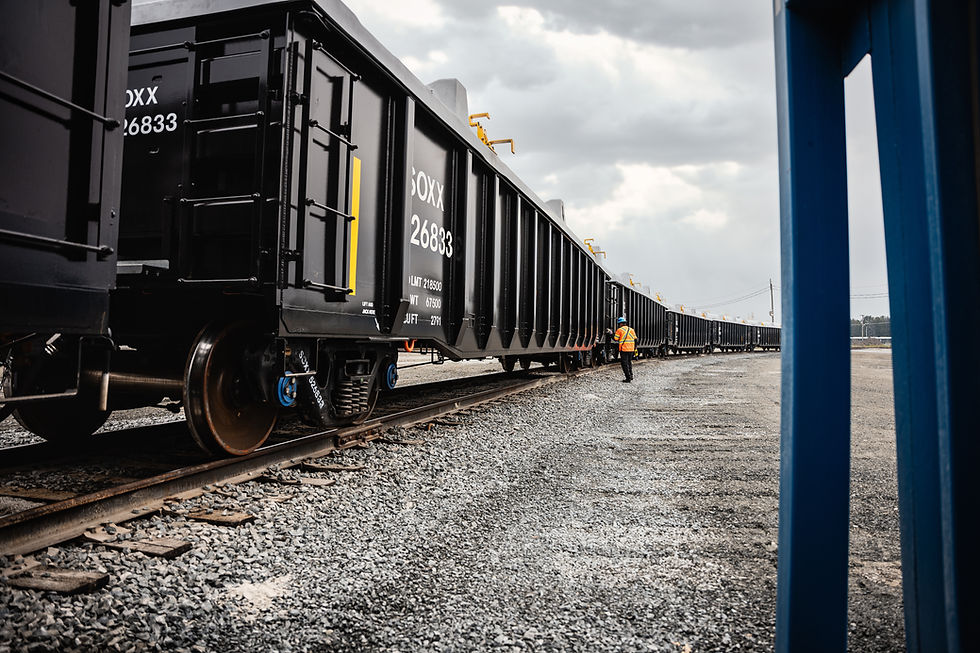Drag reduction from Rail Car Covers: Estimated 9% fuel saving for a round-trip
- Solurail

- 14 déc. 2024
- 3 min de lecture
Dernière mise à jour : 16 déc. 2024
In the rail industry, efficiency and cost-saving measures are critical for maintaining competitiveness and sustainability. One often-overlooked factor is the aerodynamic drag created by empty railcars. Studies, including research presented at the NCTA Spring Conference in 2007 by Bruce L. Storms, James C. Ross, and Dan Dzoan from NASA Ames Research Center, as well as findings from "Fuel Savings and Aerodynamic Drag Reduction from Rail Car Covers," highlight the significant role aerodynamics play in rail transport efficiency. Inspired by their findings, we explore how fiberglass rail car covers can help reduce drag, lower fuel consumption, and enhance operational performance.

Understanding Aerodynamic Drag in Empty Railcars
The studies revealed that empty coal cars, commonly used in freight operations in United-States and Canada, generate significant aerodynamic drag due to their open tops and blunt shapes. This resistance leads to increased fuel consumption, higher operational costs, and reduced overall efficiency. According to the NASA team and corroborated by the "Fuel Savings and Aerodynamic Drag Reduction from Rail Car Covers" research, addressing this issue through design modifications could drastically reduce drag and its associated costs.
The Solution: Fiberglass Rail Car Covers
Fiberglass railcar covers offer a practical, cost-effective solution to the problem of aerodynamic drag. Designed to streamline airflow over the top of the railcar, these covers minimize resistance and enhance fuel efficiency. Here are some of the key benefits:

1. Reduced Fuel Consumption
These studies demonstrated that by decreasing drag by up to 40%, railcar covers can lead to significant fuel savings over long distances. For instance, the "Fuel Savings and Aerodynamic Drag Reduction from Rail Car Covers" research estimated fuel savings of approximately 9% per train per trip when aerodynamic covers were applied with an average drag reduction of 43%, translating into substantial cost reductions for railway companies in Canada and the United States but also Worldwide.
2. Improved Operational Efficiency
With less drag and fewer weather-related interruptions, railcars equipped with fiberglass covers achieve better fuel economy, translating into more efficient logistics. These improvements align with the findings in the studies we presented which emphasized that smoother airflow leads to better train performance.
Real-World Impact: Case Studies and Results
Studies also noted that the adoption of railcar covers could lead to millions of dollars in annual fuel savings, especially for long-haul routes.
The investment in fiberglass rail car covers improved operational performance, and reduced maintenance costs. Additionally, the environmental benefits align with the growing emphasis on sustainability within the transportation sector. A train equipped with aerodynamic covers not only saves fuel but also reduces greenhouse gas emissions by an equivalent percentage.
Why Choose Our Fiberglass Railcar Covers?
At Solurail, we’ve taken the insights from NASA’s research to develop cutting-edge fiberglass covers tailored for the rail industry in partnership with Containment Systems Inc. Our products are:
Customizable to fit various railcar types and sizes.
Lightweight yet durable, ensuring ease of handling and long-term performance.
Proven to reduce drag and operational costs, backed by industry studies.
Ready to Improve Your Rail Operations?
Reducing aerodynamic drag is a straightforward way to save on fuel and enhance the efficiency of your fleet. Whether you’re transporting goods across the United-States or operating in the challenging climates of Western Canada, our fiberglass rail car covers are designed to meet your needs.

Contact us today to learn more or request a quote:
Phone: 819-874-RAIL
Email: info@solurail.com
Website: www.railcarcovers.com
Transform your rail operations with innovative solutions that deliver measurable results. Let’s move forward—together.


Commentaires